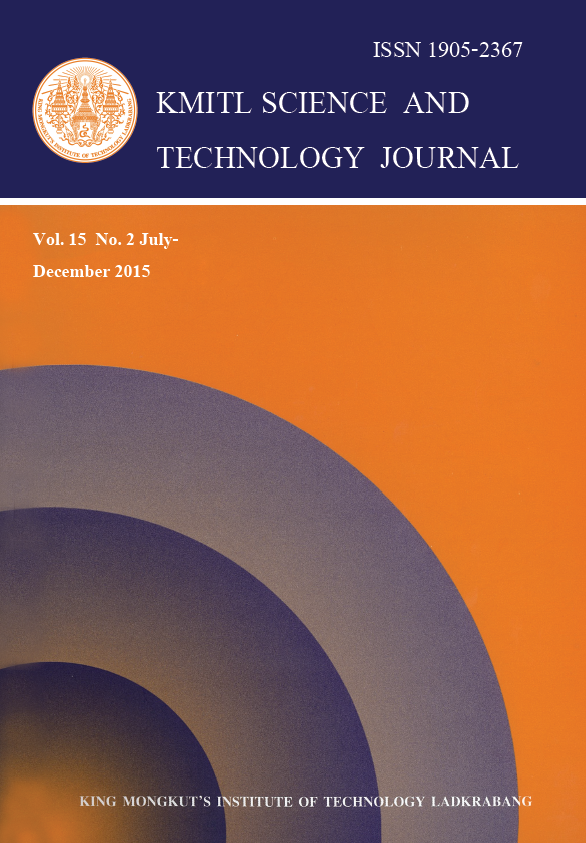Insecticide Application in Mushroom Farms: A Survey Study in Nongyaplong District, Phetchburi Province, Thailand
Main Article Content
Abstract
A survey of insecticide application behaviors of mushroom farmers in Nongyaplong district, Phetchburi province, Thailand was made during August-September, 2014. Thirty farmers were sampled who generally worked in approximately 5 mushroom houses containing about 2,000 mushroom cubes per house. The data were collected by using structured interview method. The results revealed that the most cultured mushrooms were oyster mushroom (59.3%), Jew’s ear mushroom (40.5%), and others (0.2%). It was found that in general farmers used insecticides (carbaryl, methomyl and cypermethrin) for controlling insect pests (Cyllodes sp., Drosophila sp. and Dasyses sp.) and mushroom mites (Luciaphorus perniciosus and Formicomotes heteromorphus) by using direct spray method (57.1%). The insecticide treatments were normally conducted 3-4 times a month with 1-3 days pesticide free period before the harvests. In addition, chemical products with different trade names were generally substituted when resistance of insects or mites were observed, with no consideration of the active chemicals. Insecticide treatments were normally introduced in the morning after daily harvests, and insecticide users normally wore basic chemical protection clothing and usually well rinsed after the application. The allergic symptoms were observed, users normally evacuated from the areas, cleaned themselves, and rested. It is suggested that insecticide using behaviors of the mushroom farmers could be the background information for further studies on insecticide contamination in the mushroom products.
Keywords: structure interview, allergic symptom, insecticide contamination, carbamate
*Corresponding author: Jompong_pest@hotmail.com
Article Details
Copyright Transfer Statement
The copyright of this article is transferred to Current Applied Science and Technology journal with effect if and when the article is accepted for publication. The copyright transfer covers the exclusive right to reproduce and distribute the article, including reprints, translations, photographic reproductions, electronic form (offline, online) or any other reproductions of similar nature.
The author warrants that this contribution is original and that he/she has full power to make this grant. The author signs for and accepts responsibility for releasing this material on behalf of any and all co-authors.
Here is the link for download: Copyright transfer form.pdf
References
[2] Naktae, S., 2011. Insects and Mites of Wild and Cultivated Mushroom in Nakhon Si Thammarat and Songkhla Province. Master’s Thesis, Prince of Songkla University, Thailand. (in Thai with English abstract)
[3] Entomology and Zoology Division., 2001. Insect and Mite Pests of Mushroom in Thailand. Department of Agriculture, Bangkok, Thailand.
[4] Bureau of Epidemiology., 2012. Annual Epidemiological Surveillance Report 2012. Bureau of Epidemiology, Department of Diseases Control Ministry of Public Health, Thailand. (in Thai)
[5] Anurakpongsatorn, P., Keawprasit, C., Sinbuatong, N. and Chutintrasri, B., 1998. Insecticide residues in mushroom. Kasetsart Journal (Natural Science), 22(4), 318-322. (in Thai with English abstract)
[6] Wilson, B. W. Chlolinesterases. In: Krieger, R.I., Doull, J., Ecobichon, D., Gammon, D., Hodgson, E., Reiter, L. and Ross, J., 2001. Handbook of Pesticide Toxicology. 2 nd ed.). San Diego, California: Academic Press, pp. 967-985.
[7] Pumnuan, J., Ruangsomboon, S. and Kangkunt, S., 2010. Insecticide residues in neptunia plantation water and related canals: a case study in Amphur Bangplee, Samutprakarn province. In: 16th Asian Agricultural Symposium and 1th International Symposium on Agricultural Technology. August 25-27 2010. Bangkok, Thailand, pp. 460-463.
[8] Chaigarun, S., Somboon, S. and Wanchana, S., 2013.Insecticide residues in Isan vegetable and local foods. KKU Journal for Public Health Research, 6(3), 123-129. (in Thai with English abstract)
[9] Pumnuan, J., 2003. Insecticides usages in Neptunia plantation: a case study in Amphur Bangplee, Samutprakarn province. King Mongkut’s Agricultural Journal, 21(3), 87-90. (in Thai)
[10] Chaiklang, C. and Janmanee, S. and Hnookaw, O., 2012. Detection of insecticides residues in vegetables from the market in Muang district, Suratthani province. In: Proceedings of 50th Kasetsart University Annual Conference: Science, Natural Resources and Environment. Bangkok, 31 Jun. - 2 Feb. pp. 263-271. (in Thai with English abstract)
[11] Prasopsuk, J., Saisuphan, P. and Srisawangwong, W., 2014. Analysis of pesticide residues in vegetables and fruits for the certification of good agricultural practice in upper Northeast Thailand. Khon Kaen Agriculture Journal, 42(Suppl.2), 430-439. (in Thai with English abstract)
[12] Ruangchai, S. and Inmuong, Y., 2013. Tobacco farmers’s health impact of pesticide use in Lamhuay Lua sub-district, Somdej district, Kalasin province. Journal of the Office of DPC 6 Khon Kaen, 18(1), 48-60. (in Thai with English abstract)
[13] Kishi, M., Hirschhorn, N., Djajadisastra, M., Satterlee, L.N., Strowman, S. and Dilts, R., 1995. Relationship of pesticide spraying to signs and symptoms in Indonesian farmers. Scand J Work Environ Health, 21(2), 124-33.


